Roden 1/32 SPAD VIIC.1
|
KIT #: |
604 |
|
PRICE: |
$65.00 SRP |
|
DECALS: |
Three options |
|
REVIEWER: |
Tom Cleaver |
|
NOTES: |
Pheon Decals “SPAD
VII
Lafayette Escadrille”
used |
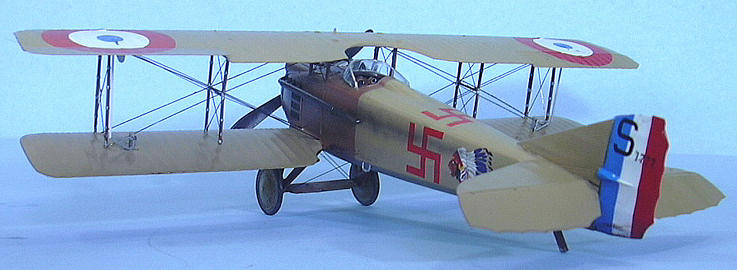
René Fonck, leading French ace of World War I with 75 victories, said
that the introduction of the SPAD
VII
fighter "...completely changed
the face of aerial warfare".
The SPAD S.VII
C.1 was the first of a series of single-seat biplane fighters produced by
Société Pour L'Aviation et ses Dérivé(SPAD) during the First World War.
The airplane was influenced by the introduction of the Albatros
fighters, which emphasized speed and maneuverability in the vertical plane
over the lighter rotary-powered fighters that had preceded it.
In February 1915, Swiss engine designer Marc Birkigt modified his
Hispano-Suiza V-8 automobile engine for use in aircraft.
The result was a 330-lb engine which produced 140 hp at 1,400 rpm.
With further refinement, the engine provided
150 hp by July 1915.
French officials ordered production be established as soon as possible and
asked aircraft designers to create a new high-performance fighter around the
engine, called the Hispano-Suiza 8A.
The result was the S.VII,
which was developed from the SPAD V, which in turn was based on the two-seat
SPAD A.2, with which it shared a unique single-bay biplane wing with
additional light struts mounted mid-bay at the junction of the flying and l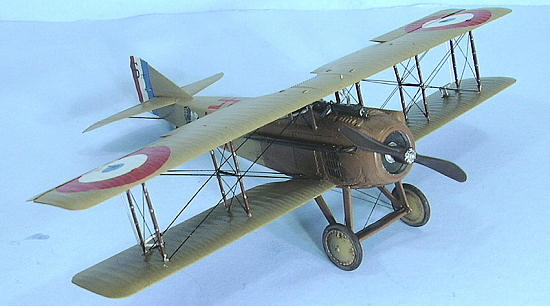 anding
wires, which simplified the inter-strut arrangement and reduced vibration of
the flying wires, which in turn reduced drag.
The result was a sturdy, rugged aircraft with good climbing and
diving abilities, as well as being a stable gun platform.
Pilots who were used to the more maneuverable rotary-powered Nieuport
fighters found the SPAD heavy
on the controls.
anding
wires, which simplified the inter-strut arrangement and reduced vibration of
the flying wires, which in turn reduced drag.
The result was a sturdy, rugged aircraft with good climbing and
diving abilities, as well as being a stable gun platform.
Pilots who were used to the more maneuverable rotary-powered Nieuport
fighters found the SPAD heavy
on the controls.
The prototype SPAD V made its first flight in April 1916. Flight
testing revealed a maximum speed of 119 mph - appreciably in advance of
other Allied fighters at the time -
and a climb rate of 4.5 minutes to 6,500 ft., which was also superior
to other Allied types. With the
soundness of the airframe construction, the SPAD V had a remarkable diving
performance superior to the Nieuport fighters, which suffered from overly
light construction, giving them a tendency to shed the wings in a steep
dive. With such performance,
the French authorities made an initial production contract on
May 10, 1916,
for 268 aircraft to be designated SPAD
VII
C.1 (C.1 indicated it was a single-seat fighter, or Chasseur).
Unfortunately, the early production aircraft revealed several defects
which took time to resolve. The major problem encountered was with the
engine, which was prone to overheating in hot weather.
One cure was to add additional louvers on the engine cowling panels
to increase airflow over the
engine. Additionally, the
cowling opening was first enlarged and eventually redesigned with vertical
shutters to solve the problem. The engine mount was too weak and
reinforcements were designed. The early aircraft were also equipped with two
ammunition drums - one for loaded rounds and the other for empties, which
was prone to jamming. The
problem was finally solved when Prideaux disintegrating links were
introduced.
The first SPAD VIII aircraft delivered to an operational was S.112,
flown by Lt. Sauvage of Escadrille N.65.
S.113 was assigned to Lt. Georges Guynemer of Escadrille N.3,
who was credited with 15 victories.
Armand Pinsard of Escadrille N.26
scored the first aerial victory on
August 16, 1916,
in S.122.
Due to the engine problems, the initial introduction of the SPAD
VII
was did not change the balance of the air war but it allowed both pilots and
mechanics to familiarize themselves with the new fighter. Many pilots
thought the airplane lacked maneuverability and some reverted to their
nimble Nieuports while waiting for the SPAD
VII
to become more reliable. New tactics based on speed and performance in the
vertical plane were developed to take advantage of the SPAD's power, and to
compensate for its relative lack of maneuverability. The ability to dive
safely at up to 249 mph provided the ability to leave combat without fear of
pursuit if the situation demanded it.
The SPAD
VII
was gradually replaced in the latter part of 1917 by the improved SPAD XIII,
was had a 220 h.p. Hispano Suiza and carried two machine guns rather than
one, though the SPAD
VII
remained on operations with the Aviation Militaire and the Italians
until the end of the war, though the French eventually used it as a trainer.
The SPAD
VII
was used as the standard pilot certificate test aircraft until 1928.
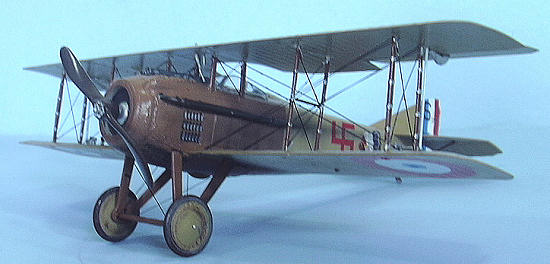 Raoul
Lufbery And The
Lafayette
Escadrille:
Raoul
Lufbery And The
Lafayette
Escadrille:
Before the entry of United States in 1917, one of the most famous
units in the Aviation Militaire was the Lafayette Escadrille,
which was organized in April, 1916 by Dr. Edmund L. Gros, director of the
American Ambulance Service, and Norman Prince, an American expatriate
already flying with the French, as the Escadrille Américaine.
The French stationed the unit Luxeuil and provided a commander -
Captain Georges Thénault - equipping the unit with Nieuport 17s.
Thus, their official designation was Escadrille Nieuport 124
or simply N.124. The use of
Américaine in their name prompted German diplomatic complaints, which
resulted in the unit being renamed the Escadrille Lafayette, which
had an even more emotive response with the American public.
Kiffin Rockwell scored the first victory, a German L.V.G. two-seater,
on May 18, 1916. Shortly after, the unit moved to Bar-le-Duc, an airfield
near
Verdun,
where they took part in the heavy fighting over the fortress.
After several casualties, they returned to Luxeuil for further
training, where they adopted their famous mascot, a lion cub named
“Whiskey,” who was later joined by a second, named “Soda.”
Publicized by the French for propaganda purposes, the fame of the 38
American pilots exceeded their impact in combat - over 20 months of combat,
they downed 57 German planes, which was a solid, though unspectacular,
achievement.
Gervais Raoul Lufbery - who would become the leading ace of the
Lafayette Escadrille - was born on
March 14, 1885
in
France.
His father moved to
Connecticut
and established a stamp dealership, while Raoul was raised by his
grandmother until he sailed for
America
at age 19. Ironically, his father sailed for
Europe
the same day, and they never saw each other again. Raoul stayed in
Wallingford, Connecticut, for two years, where he learned to speak a little
English before traveling to
Cuba
and back. A stint with the
U.S.
Army in the
Philippines
earned him American citizenship, after which he left for the
Far East.
In 1912, Lufbery met the renowned aviator Marc Pourpe, who was
barnstorming
Indochina
in his Blériot. Lufbery went to
work for Pourpe as foreman and mechanic, and the two moved on to Europe and
Africa, where Pourpe made the first round-trip Cairo-to-Khartoum flight in
1913, with Lufbery in charge of fuel, maintenance, and spare parts.
Later that year, the two saw combat when Pourpe flew for the
Bulgarians in the Second Balkan War and became the first pilot to drop bombs
from his aircraft.
Following the outbreak of war in August, 1914, Lufbery joined the French
Foreign Legion as an infantryman.
He was quickly transferred to Pourpe's squadron of the Aviation Militaire
as a mechanic. Pourpe was killed a few months later
and Lufbery enrolled in pilot training at
Chartres.
After learning to fly on the Farman, he joined Escadrille VB (Voisin) 106.
He was recognized as a competent pilot and applied to fly fighters. After
some opposition from his commander he went to Plessis-Belleville for training on
Nieuport scouts. He was not a naturally gifted pilot, but he was persistent and
became a decent pilot.
 Upon completion of fighter training, Lufbery as assigned to the
Lafayette Escadrille. At first, he didn't fit in with the college boys,
being several years older than most of them and seeming crude and unfriendly at
first. His scored his first victory on July 30 over
Verdun,
with a second later the same day. By October 12, he scored three more and was an
ace - the leading flier of the Lafayette Escadrille.
Lufbery downed his seventh in January, 1917, shortly after the unit
re-equipped with the SPAD
VII
C.1 over the Christmas holiday.
Upon completion of fighter training, Lufbery as assigned to the
Lafayette Escadrille. At first, he didn't fit in with the college boys,
being several years older than most of them and seeming crude and unfriendly at
first. His scored his first victory on July 30 over
Verdun,
with a second later the same day. By October 12, he scored three more and was an
ace - the leading flier of the Lafayette Escadrille.
Lufbery downed his seventh in January, 1917, shortly after the unit
re-equipped with the SPAD
VII
C.1 over the Christmas holiday.
Following the entry into the war of the
United States,
Lufbery - who then had 16 victories and was the leading American ace of the war
- was one of the first members of the Lafayette Escadrille to be selected
for American service. Given the
rank of Major, he was assigned to the as-yet unformed 94th Aero
Squadron. The rest of the Americans in the
Lafayette
Escadrille became the 103rd Aero Squadron of the
U.S.
Army Air Service in February, 1918.
In early March, 1918, when the Germans staged their last great offensive,
Lufbery and the other experienced American pilots had no role to play. "It's
nearly a year since the United States declared war," Lufbery complained, "And
what do you suppose the 94th is doing? Waiting for machine guns."
Tired of waiting, Lufbery led Eddie Rickenbacker and Doug Campbell on the 94th's
first patrol on March 19, despite the fact that all three were unarmed..
As Lufbery began flying with the 94th, he became moody and
irritable, worrying about his Nieuport 28 and obsessing over a fear of fire in
the air.
On May 19, 1918, Lieutenant Gude of the 94th engaged an
Albatros two-seater over the unit’s airfield at Saint-Mihiel. This was Gude's
first combat; it seemed at first that he had scored against the Albatros, but
after spiraling down the German pilot pulled out and headed for home.
Anxious to score over Allied lines to show Americans were in the war,
Lufbery took off after the escaping Albatros. Those
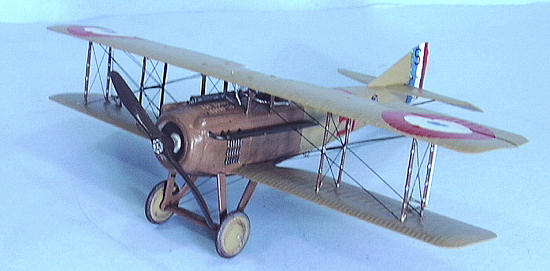 below
expected him to score easily. He made one pass, then moved off, likely to clear
a jam. The Albatros’ rear seater
then hit the Nieuport, which caught fire. Lufbery was seen to climb out of the
cockpit and jump from about 200 feet over the village of Maron. He was impaled
on a picket fence and his body recovered by a woman and her daughter.
General Billy Mitchell watched, and later regretted that America's
leading flier had not been carrying a parachute, which was not yet regulation
equipment.
below
expected him to score easily. He made one pass, then moved off, likely to clear
a jam. The Albatros’ rear seater
then hit the Nieuport, which caught fire. Lufbery was seen to climb out of the
cockpit and jump from about 200 feet over the village of Maron. He was impaled
on a picket fence and his body recovered by a woman and her daughter.
General Billy Mitchell watched, and later regretted that America's
leading flier had not been carrying a parachute, which was not yet regulation
equipment.
Two Lafayette Escadrille fliers, James Norman Hall and Charles
Nordhoff, wrote the world-famous novel, “Mutiny on the Bounty,” which has been
made into a movie three times since it was first published in 1932.
Another Lafayette Flying Corps pilot (those Americans who did not
serve directly in the Lafayette Escadrille but flew with other units),
William Wellman, became a motion picture director after the war and won the
first Academy Award for directing “Wings.”
Raoul Lufbery did not invent the defensive aerial tactic known as the
Lufbery circle.
The better-known SPAD XIII was among the very first airplanes to be
recreated as a plastic model when Hawk released a 1/48 kit in 1951, which is
still available and can still be made into an acceptable model, though it has
been long obsolete, beginning with the Aurora SPAD XIII released in 1957, while
the Revell 1/28 SPAD XIII is still the king of big kits 52 years after its
initial release. The Hobbycraft
1/32 SPAD XIII can be made into an excellent model, though there is not a good
decal sheet for this kit.
The SPAD
VII
is a fairly-recent phenomenon in injection plastic, with kits in 1/72 and 1/48
released by Special Hobby over the past 7 years.
This SPAD
VII
by Roden is the first kit of this airplane to appear in 1/32.
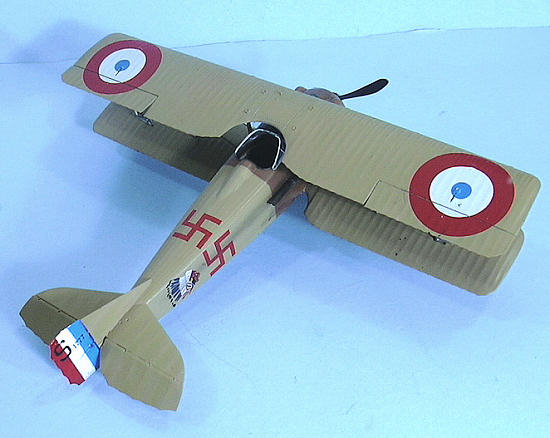 Produced in Roden’s standard light tan plastic, the kit provides good
detail, with a full Hispano engine and a fully-detailed cockpit.
The cockpit lacks seat belts, but it is a simple matter to make them from
Lead Foil or to get Eduard’s photoetch set.
Decals are provided to make three aircraft, including “Revanche IV” that
was flown Armand Pinsard, the first pilot to score a victory in a SPAD
VII,
the SPAD
VII
of Escadrille N.23 flown by Maxime Lenoir, and the famous “Le Grand Charles,”
flown by Georges Guynemer of Escadrille N.3.
Produced in Roden’s standard light tan plastic, the kit provides good
detail, with a full Hispano engine and a fully-detailed cockpit.
The cockpit lacks seat belts, but it is a simple matter to make them from
Lead Foil or to get Eduard’s photoetch set.
Decals are provided to make three aircraft, including “Revanche IV” that
was flown Armand Pinsard, the first pilot to score a victory in a SPAD
VII,
the SPAD
VII
of Escadrille N.23 flown by Maxime Lenoir, and the famous “Le Grand Charles,”
flown by Georges Guynemer of Escadrille N.3.
Of these three, “Revanche IV” is most likely a
later-production SPAD
VII,
which differs in detail around the radiator from what is done in the kit.
Out of the box, the kit most closely approximates an early-production
SPAD
VII,
though there is some necessary modification work to be done to get this to more
closely resemble the early version.
The decals are off as regards color.
Fortunately, Pheon Decals, a new company in the UK specializing in First
World War decals (they aim to ultimately replace the now-defunct Americal-Gryphon),
has produced an excellent, well-researched set of decals to cover five SPAD VIIs
flown by the Lafayette Escadrille and one airplane flown by the 103rd
Pursuit Squadron in American service.
Assembly of the kit is quite “fiddly.”
I found it best to assemble the fuselage separately without the cowling
covers, then insert the completed cockpit assembly through the open forward
fuselage. I particularly liked the
separate turtleback, which solved the problem of how to avoid having the
centerline seam wreck the fabric effect on the upper rear fuselage.
I then attached the lower wing and the gas tank.
I then discovered that the engine is too big to be inserted in the
fuselage and have the cowling cover it correctly.
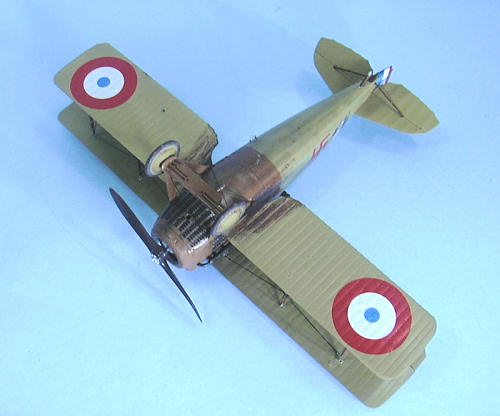 Fortunately,
one cannot see the engine once it is installed, so following my dictate “if you
can’t see it, I didn’t do it” will allow assembly to proceed with a minimum of
further difficulty. The engine is
nicely detailed, and is worth assembling and painting for separate display.
Fortunately,
one cannot see the engine once it is installed, so following my dictate “if you
can’t see it, I didn’t do it” will allow assembly to proceed with a minimum of
further difficulty. The engine is
nicely detailed, and is worth assembling and painting for separate display.
You should use the side cowling panels that have the least number of
louvers on them, which is correct for the early production SPAD
VII,
though the instructions are unclear here.
The radiator and cowling nose are supposed to represent the early SPAD
VII,
but really represent the mid-production radiator, due to the enlarged opening.
If you want to do an early SPAD
VII,
I found that you can use one of the extra wheels (which are for the late
production version); ream out the center and smooth it, then sand down the outer
rim until it fits inside the cowling opening.
With a bit of cyanoacrylate to fill the gap there, you can have the
correct early cowling.
Surprisingly, the landing gear axle is too wide.
The SPAD series have a narrow gear with the gear legs only slightly
splayed out from the vertical.
After comparing this with the correct-length axle on my Hobbycraft SPAD XIII, I
ended up taking out 1/4 inch from the middle of the axle, gluing it back
together and filling and sanding the joint.
With that done, the landing gear looks right.
The ailerons are separate, but the joint is very fiddly and weak.
While I managed to pose the ailerons dynamically after several attempts,
I would suggest this is a model that wants the ailerons posed in the neutral
position. I attached the horizontal
stabilizer with the elevators drooped.
I did not attach the rudder to the vertical fin, since it would be easier
to apply the rudder stripes with it separate
Painting:
I applied a mixed color based on Tamiya “Buff” with a bit of Yellow added
to get the color for the Fabric.
The forward fuselage was painted with a mixed color ba sed
on Tamiya “Desert Yellow” with a bit of Red Brown added in.
The struts were painted a mixed color of brown and yellow to represent
“Yew.” I then gave the model a coat
of Future when this was all dry.
sed
on Tamiya “Desert Yellow” with a bit of Red Brown added in.
The struts were painted a mixed color of brown and yellow to represent
“Yew.” I then gave the model a coat
of Future when this was all dry.
Decals:
The Pheon Decals went on without problem.
These are excellent decals that are very thin, yet do not crumple
together and don’t want to stick to the first surface they touch.
The colors are completely accurate.
The decals snug down under a light coat of Micro-Sol without further
problem.
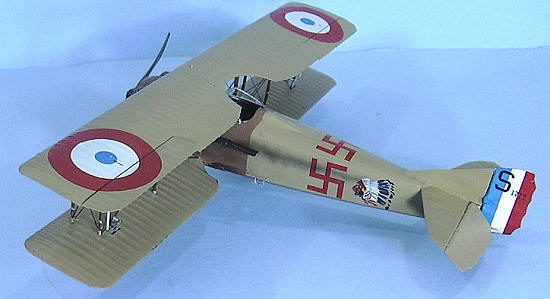 I washed the model to get rid of decal solvent residue, then gave it a
coat of Xtracrylix Gloss Varnish, which is less glossy than Future.
I attached the wheels and “muddied them up,” and applied some mud spray
to the underside of the wings and the fuselage.
I used Tamiya “Smoke” for the oil and exhaust stains, then attached the
exhausts, followed by the gun and then the windscreen.
I washed the model to get rid of decal solvent residue, then gave it a
coat of Xtracrylix Gloss Varnish, which is less glossy than Future.
I attached the wheels and “muddied them up,” and applied some mud spray
to the underside of the wings and the fuselage.
I used Tamiya “Smoke” for the oil and exhaust stains, then attached the
exhausts, followed by the gun and then the windscreen.
I attached the cabane struts and the outer wing struts.
Since the SPAD rigging is very “fiddly,” I decided to rig the model
before attaching the upper wing. I had drilled out the attachment holes for the
struts to make them easy to use, then rigged the model using .006 wire that was
painted black for effect (I don’t know that they actually were black, but they
are a “dark color” in period photos.
Once this was all set, I attached the upper wing, which was fairly easy
since it is easy to get the right alignment of the struts and attaching the
rigging beforehand keeps everything in the proper position.
The SPADS are among my favorite World War I airplanes, and I am very glad
to finally have a good SPAD
VII
in this scale. The model looks
great sitting next to the Hobbycraft SPAD XIII on the First World War shelf.
Roden is to be commended for making such a nice kit.
It is fiddly, and not recommended for the tyro World War I modeler,
though modelers with some experience doing “fiddly” biplanes should have no
trouble.
Review kit courtesy of Roden
and
thanks to Pheon Decals for their decal sheet.
Tom Cleaver
June 2009
Copyright ModelingMadness.com. All rights reserved. No reproduction in any form without express permission from the editor.
If you would like your product reviewed fairly and quickly, please
contact the editor or see other details in the
Note to
Contributors.
Back to the Main Page
Back to the Review Index Page


 anding
wires, which simplified the inter-strut arrangement and reduced vibration of
the flying wires, which in turn reduced drag.
The result was a sturdy, rugged aircraft with good climbing and
diving abilities, as well as being a stable gun platform.
Pilots who were used to the more maneuverable rotary-powered Nieuport
fighters found the SPAD heavy
on the controls.
anding
wires, which simplified the inter-strut arrangement and reduced vibration of
the flying wires, which in turn reduced drag.
The result was a sturdy, rugged aircraft with good climbing and
diving abilities, as well as being a stable gun platform.
Pilots who were used to the more maneuverable rotary-powered Nieuport
fighters found the SPAD heavy
on the controls. Raoul
Lufbery And The
Raoul
Lufbery And The 
 below
expected him to score easily. He made one pass, then moved off, likely to clear
a jam. The Albatros’ rear seater
then hit the Nieuport, which caught fire. Lufbery was seen to climb out of the
cockpit and jump from about 200 feet over the village of Maron. He was impaled
on a picket fence and his body recovered by a woman and her daughter.
General Billy Mitchell watched, and later regretted that America's
leading flier had not been carrying a parachute, which was not yet regulation
equipment.
below
expected him to score easily. He made one pass, then moved off, likely to clear
a jam. The Albatros’ rear seater
then hit the Nieuport, which caught fire. Lufbery was seen to climb out of the
cockpit and jump from about 200 feet over the village of Maron. He was impaled
on a picket fence and his body recovered by a woman and her daughter.
General Billy Mitchell watched, and later regretted that America's
leading flier had not been carrying a parachute, which was not yet regulation
equipment.  Produced in Roden’s standard light tan plastic, the kit provides good
detail, with a full Hispano engine and a fully-detailed cockpit.
The cockpit lacks seat belts, but it is a simple matter to make them from
Lead Foil or to get Eduard’s photoetch set.
Decals are provided to make three aircraft, including “Revanche IV” that
was flown Armand Pinsard, the first pilot to score a victory in a SPAD
Produced in Roden’s standard light tan plastic, the kit provides good
detail, with a full Hispano engine and a fully-detailed cockpit.
The cockpit lacks seat belts, but it is a simple matter to make them from
Lead Foil or to get Eduard’s photoetch set.
Decals are provided to make three aircraft, including “Revanche IV” that
was flown Armand Pinsard, the first pilot to score a victory in a SPAD
 Fortunately,
one cannot see the engine once it is installed, so following my dictate “if you
can’t see it, I didn’t do it” will allow assembly to proceed with a minimum of
further difficulty. The engine is
nicely detailed, and is worth assembling and painting for separate display.
Fortunately,
one cannot see the engine once it is installed, so following my dictate “if you
can’t see it, I didn’t do it” will allow assembly to proceed with a minimum of
further difficulty. The engine is
nicely detailed, and is worth assembling and painting for separate display. sed
on Tamiya “Desert Yellow” with a bit of Red Brown added in.
The struts were painted a mixed color of brown and yellow to represent
“Yew.” I then gave the model a coat
of Future when this was all dry.
sed
on Tamiya “Desert Yellow” with a bit of Red Brown added in.
The struts were painted a mixed color of brown and yellow to represent
“Yew.” I then gave the model a coat
of Future when this was all dry. I washed the model to get rid of decal solvent residue, then gave it a
coat of Xtracrylix Gloss Varnish, which is less glossy than Future.
I attached the wheels and “muddied them up,” and applied some mud spray
to the underside of the wings and the fuselage.
I used Tamiya “Smoke” for the oil and exhaust stains, then attached the
exhausts, followed by the gun and then the windscreen.
I washed the model to get rid of decal solvent residue, then gave it a
coat of Xtracrylix Gloss Varnish, which is less glossy than Future.
I attached the wheels and “muddied them up,” and applied some mud spray
to the underside of the wings and the fuselage.
I used Tamiya “Smoke” for the oil and exhaust stains, then attached the
exhausts, followed by the gun and then the windscreen.